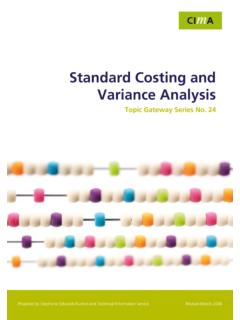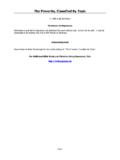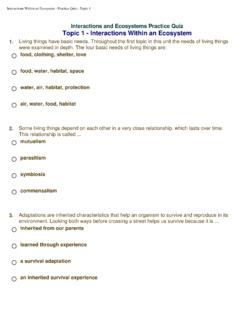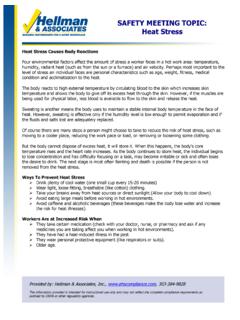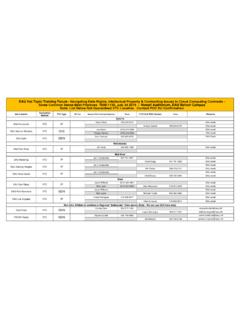Transcription of Topic 7: Introduction to quality improvement …
1 Topic 7: Introduction to quality improvement methods Why students need to know about make improvements;. quality improvement methods 1 being aware that the way people think and Students will be familiar with the term react is as important as the structures and evidence-based medicine and the randomized processes in place;. controlled trial, which has enabled medicine to realizing that the spread of innovative establish if a particular treatment is validated by practices is a result of people adopting new evidence or merely one that rests on belief of the processes and not the other way around. practitioners. Research methods such as the randomized controlled trial measure clinical Most quality improvement methods are based on effectiveness.
2 But such methods do not measure the application of continuous quality improvement contextual components or the process of care. theory developed by the manufacturing industry. The problems in health systems are significantly The principle underpinning quality improvement affected by the processes of care and a was that quality was not something controlled at randomized controlled trial will not measure the the end of the line, but rather throughout the problems nor fix them. Students need to be aware entire work process. This Topic explains some of that process measures require different methods. the underlying theory. The science of improvement is new to medicine and as a result there has been debate about Traditional attempts to persuade and influence whether the measures of quality improvement are clinicians to change behaviour, such as rigorous enough.
3 Berwick has captured this compliance with a protocol or vigilance in regard debate in a paper published in 2008 where he to drug interactions in the interest of improving the argued that both research methods are necessary quality of patient care, have by and large failed. to improve health-care research for improving There have been thousands of recommendations clinical evidence and research for improving by hundreds of committees and peer groups for processes of care [1]. improving the safety and quality of patient care over decades, yet there is little evidence that quality improvement methods are designed to clinicians have changed their practice because of study processes and have been successfully used them.
4 The publication of evidence in peer for decades in other industries. In health care, reviewed journals, does not necessarily lead in of students will be familiar with the goal of scientific itself , to clinicians' changing their practice. Many research, which is to discover new knowledge but articles outline best practice and make urgent they will be less familiar with quality improvement , recommendations for changes as a result of new which is to change performance [2]. Students are information [3]. encouraged to observe or join a team undertaking an improvement activity. Medical students can quality improvement methods have successfully begin to understand the role of quality addressed this gap and provide clinicians with the improvement methods by: tools to: (i) identify a problem; (ii) measure the asking about measures that improve quality problem; (iii) develop a range of interventions and safety; designed to fix the problem; and (iv) test whether recognizing that good ideas can come from the interventions worked.
5 Anyone;. being aware that the situation in the local Tom Nolan, Brent James, Don Berwick and others environment is a key factor in trying to have applied quality improvement principles in 165. Topic 7: Introduction to quality improvement methods developing quality improvement methods for to apply the principles and use the tools to health clinicians and managers. The identification undertake their own improvement project. and examination of each step in the process of health-care delivery is the bedrock of this What students need to know (knowledge methodology. When students examine each step requirements): 3. in the process of care they begin to see how the the science of improvement .
6 Pieces of care are connected and measurable. the quality improvement model;. Measurement is critical for safety improvement . change concepts;. two examples of continuous improvement A range of quality improvement methods have methods;. been designed. Below are some more common methods for providing information on examples: clinical care. clinical practice improvement (CPI);. root cause analysis to retrospectively examine What students need to do (performance what went wrong; requirement): 4. failure modes and effects analysis to know how to perform a range of prospectively consider what might go wrong. improvement activities and tools. Keywords WHAT STUDENTS NEED TO KNOW. (KNOWLEDGE REQUIREMENTS).
7 quality improvement methods, PDSA cycle, change concepts, continuous improvement The science of improvement methods, variation, CPI, root cause analysis, 5. W Edwards Deming, the father of flowcharts, Cause and effect diagrams improvement theory, described the following four (Ishikawa/fishbone), Pareto charts, histograms, components of knowledge that underpin run charts. improvement : [4]. appreciation of a system;. Learning objective 2. understanding of variation;. The objectives of this Topic are to describe the theory of knowledge;. principles of quality improvement and to introduce psychology. students to the basic methods and tools for improving the quality of health care.
8 Deming stated that we do not need to understand these components in depth to apply the Learning outcomes: knowledge and knowledge. An analogy used by improvement performance leaders ( Langley; Nolan [4,5]) is that we can This Topic is an important one for students to drive a car without understanding how it works. understand because improvement will only be Students beginning their medical careers only achieved and sustained through continuous need a basic understanding of the science of measurement. However, it will also be one of the improvement . It is more important to be familiar most difficult because many hospitals and clinics with the methods used to improve the processes do not measure the processes of their care.
9 An of care. effective way for students to understand the benefits of using quality improvement methods is 166. Topic 7: Introduction to quality improvement methods Appreciation of a system predicting what is necessary to pass exams. In applying Deming's concepts to the health care, Those with specific experiences may be better at we need to remember that most patient care focused predictions. For example, health outcomes or services result from a complex professionals who work in particular health-care system of interaction between health-care settings such as a rural clinic may be better at professionals, treatment procedures and medical predicting the results of a change in this equipment.
10 Therefore, it is important that medical environment. Because they have more knowledge students understand the interdependencies and about these clinics and the way they function or relationships among all of these components should function and the way the change will (doctors, nurses, patients, treatments, equipment, impact on the patients and their families. When procedures, theatres and so on) thereby health professionals have experience and increasing the accuracy of predictions about any knowledge of the area they wish to change it is impact that changes may have on the system. more likely that the change will result in an improvement . Comparing the results with the Understanding of variation predictions is important learning.










